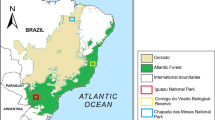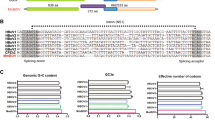Abstract
The discovery of novel viruses in wild animals allows the prediction of their potential threat to the health of humans and other animals. We report a highly divergent picornavirus (tentatively named “mobovirus A”), identified in a fecal sample from Macaca mulatta in Yunnan province, China, using viral metagenomic analysis, with viral loads of 2 × 107 copies/g. The complete genomic sequence of mobovirus A is 8,325 nucleotides in length. Phylogenetic analysis showed that it clustered with Guangxi changeable lizard picornavirus 1 and Guangxi Chinese leopard gecko picornavirus, with less than 38%, 40%, and 40% amino acid identity in the P1, P2, and P3 protein, respectively. The viruses in this cluster were most closely related to members of the genera Harkavirus, Tremovirus and Hepatovirus. Genomic analysis revealed that mobovirus A has the typical genomic organization and motifs of a picornavirus. Additionally, its codon usage bias complements that of M. mulatta, suggesting that this feature is not restricted only to hepatoviruses. Thus, according to the guidelines of the Picornaviridae Study Group of the International Committee on Taxonomy of Viruses, mobovirus A should be considered a member of a new genus (tentatively named for Monkey-borne virus, “Mobovirus”) in the family Picornaviridae. These data will facilitate the understanding of the genetic diversity and evolution of picornaviruses. Further studies are needed to understand the epidemiology and potential pathogenicity of the virus in M. mulatta.



Similar content being viewed by others
Notes
The GenBank [/EMBL/DDBJ] accession number for the complete genome nucleotide sequence of the novel picornavirus found in this study is MF370941.
References
King A, Lefkowitz EJ, Mushegian AR, Adams MJ, Dutilh BE, Gorbalenya AE, Harrach B, Harrison RL, Junglen S, Knowles NJ, Kropinski AM, Krupovic M, Kuhn JH, Nibert ML, Rubino L, Sabanadzovic S, Sanfacon H, Siddell SG, Simmonds P, Varsani A, Zerbini FM, Davison AJ (2018) Changes to taxonomy and the international code of virus classification and nomenclature ratified by the international committee on taxonomy of viruses. Arch Virol 162:2505–2538
Zell R, Delwart E, Gorbalenya AE, Hovi T, King A, Knowles NJ, Lindberg AM, Pallansch MA, Palmenberg AC, Reuter G, Simmonds P, Skern T, Stanway G, Yamashita T, Ictv RC (2017) ICTV virus taxonomy profile: Picornaviridae. J Gen Virol 98:2421–2422
Jackson RJ, Hellen CU, Pestova TV (2010) The mechanism of eukaryotic translation initiation and principles of its regulation. Nat Rev Mol Cell Biol 11:113–127
Fuentes-marins R, Rodriguez AR, Kalter SS, Hellman A, Crandell RA (1963) Isolation of enteroviruses from the “normal” baboon (papio doguera). J Bacteriol 85:1045–1050
Malherbe Harwin R (1963) The cytopathic effects of vervet monkey viruses. S Afr Med J 37:407–411
Oberste MS, Feeroz MM, Maher K, Nix WA, Engel GA, Hasan KM, Begum S, Oh G, Chowdhury AH, Pallansch MA, Jones-Engel L (2013) Characterizing the picornavirus landscape among synanthropic nonhuman primates in Bangladesh, 2007 to 2008. J Virol 87:558–571
Oberste MS, Maher K, Pallansch MA (2003) Genomic evidence that simian virus 2 and six other simian picornaviruses represent a new genus in Picornaviridae. Virology 314:283–293
Oberste MS, Maher K, Pallansch MA (2002) Molecular phylogeny and proposed classification of the simian picornaviruses. J Virol 76:1244–1251
Anthony SJ, St LJ, Liang E, Hicks AL, Sanchez-Leon MD, Jain K, Lefkowitch JH, Navarrete-Macias I, Knowles N, Goldstein T, Pugliares K, Ip HS, Rowles T, Lipkin WI (2013) Shift of Enterovirus species among children in Cameroon—identification of a new enterovirus, EV-A119. J Clin Virol 58:227–232
Sadeuh-Mba SA, Bessaud M, Massenet D, Joffret ML, Endegue MC, Njouom R, Reynes JM, Rousset D, Delpeyroux F (2013) High frequency and diversity of species C enteroviruses in Cameroon and neighboring countries. J Clin Microbiol 51:759–770
Bessaud M, Pillet S, Ibrahim W, Joffret ML, Pozzetto B, Delpeyroux F, Gouandjika-Vasilache I (2012) Molecular characterization of human enteroviruses in the Central African Republic: uncovering wide diversity and identification of a new human enterovirus A71 genogroup. J Clin Microbiol 50:1650–1658
Oberste MS, Maher K, Michele SM, Belliot G, Uddin M, Pallansch MA (2005) Enteroviruses 76, 89, 90 and 91 represent a novel group within the species Human enterovirus A. J Gen Virol 86:445–451
Ao YY, Yu JM, Zhang CY, Xin YY, Li LL, Duan ZJ (2016) Identification of a novel Enterovirus Species in Rhesus Macaque in China. Sci Rep 6:28526
Finkbeiner SR, Allred AF, Tarr PI, Klein EJ, Kirkwood CD, Wang D (2008) Metagenomic analysis of human diarrhea: viral detection and discovery. Plos Pathog 4:e1000011
Sánchez G, Bosch A, Pintó RM (2003) Genome variability and capsid structural constraints of hepatitis A virus. J Virol 77:452–459
Wright F (1990) The effective number of codons used in a gene. Gene 87:23–29
Ng TF, Sachsenroder J, Reuter G, Knowles NJ, Delwart E, Johne R (2015) Rabovirus: a proposed new picornavirus genus that is phylogenetically basal to enteroviruses and sapeloviruses. Arch Virol 160:2569–2575
Saleh L, Rust RC, Fu¨llkrug R, Beck E, Bassili G, Ochs K, Niepmann M (2001) Functional interaction of translation initiation factor eIF4G with the foot-and-mouth disease virus internal ribosome entry site. J Gen Virol 82:757–763
Brown EA, Zajac AJ, Lemon SM (1994) In vitro characterization of an internal ribosomal entry site (IRES) present within the 5’ nontranslated region of hepatitis A virus RNA: comparison with the IRES of encephalomyocarditis virus. J Virol 68:1066–1074
Cohen JI, Ticehurst JR, Purcell RH, Buckler-White A, Baroudy BM (1987) Complete nucleotide sequence of wild-type hepatitis A virus: comparison with different strains of hepatitis A virus and other picornaviruses. J Virol 61:50–59
Hughes PJ, Stanway G (2000) The 2A proteins of three diverse picornaviruses are related to each other and to the H-rev107 family of proteins involved in the control of cell proliferation. J Gen Virol 81:201–207
Marvil P, Knowles NJ, Mockett AP, Britton P, Brown TD, Cavanagh D (1999) Avian encephalomyelitis virus is a picornavirus and is most closely related to hepatitis A virus. J Gen Virol 80:653–662
Yu JM, Li LL, Zhang CY, Lu S, Ao YY, Gao HC, Xie ZP, Xie GC, Sun XM, Pang LL, Xu JG, Lipkin WI, Duan ZJ (2016) A novel hepatovirus identified in wild woodchuck Marmota himalayana. Sci Rep 6:22361
Gorbalenya AE, Koonin EV, Donchenko AP, Blinov VM (1989) Two related superfamilies of putative helicases involved in replication, recombination, repair and expression of DNA and RNA genomes. Nucleic Acids Res 17:4713–4730
Gorbalenya AE, Donchenko AP, Blinov VM, Koonin EV (1989) Cysteine proteases of positive strand RNA viruses and chymotrypsin-like serine proteases. A distinct protein superfamily with a common structural fold. Febs Lett 243:103–114
Kamer G, Argos P (1984) Primary structural comparison of RNA-dependent polymerases from plant, animal and bacterial viruses. Nucleic Acids Res 12:7269–7282
Shi M, Lin XD, Chen X, Tian JH, Chen LJ, Li K, Wang W, Eden JS, Shen JJ, Liu L, Holmes EC, Zhang YZ (2018) The evolutionary history of vertebrate RNA viruses. Nature 556:197–202
Boros A, Pankovics P, Simmonds P, Pollak E, Matics R, Phan TG, Delwart E, Reuter G (2015) Genome analysis of a novel, highly divergent picornavirus from common kestrel (Falco tinnunculus): the first non-enteroviral picornavirus with type-I-like IRES. Infect Genet Evol 32:425–431
Drexler JF, Corman VM, Lukashev AN, van den Brand JM, Gmyl AP, Brunink S, Rasche A, Seggewibeta N, Feng H, Leijten LM, Vallo P, Kuiken T, Dotzauer A, Ulrich RG, Lemon SM, Drosten C (2015) Evolutionary origins of hepatitis A virus in small mammals. Proc Natl Acad Sci USA 112:15190–15195
Gonzalez JP, Pourrut X, Leroy E (2007) Ebolavirus and other filoviruses. Curr Top Microbiol Immunol 315:363–387
Keele BF, Van Heuverswyn F, Li Y, Bailes E, Takehisa J, Santiago ML, Bibollet-Ruche F, Chen Y, Wain LV, Liegeois F, Loul S, Ngole EM, Bienvenue Y, Delaporte E, Brookfield JF, Sharp PM, Shaw GM, Peeters M, Hahn BH (2006) Chimpanzee reservoirs of pandemic and nonpandemic HIV-1. Science 313:523–526
Anthony SJ, St LJ, Liang E, Hicks AL, Sanchez-Leon MD, Jain K, Lefkowitch JH, Navarrete-Macias I, Knowles N, Goldstein T, Pugliares K, Ip HS, Rowles T, Lipkin WI (2015) Discovery of a novel hepatovirus (phopivirus of seals) related to human hepatitis a virus. Mbio. https://doi.org/10.1128/mBio.01180-15
Jang SK, Pestova TV, Hellen CU, Witherell GW, Wimmer E (1990) Cap-independent translation of picornavirus RNAs: structure and function of the internal ribosomal entry site. Enzyme 44:292–309
Sweeney TR, Dhote V, Yu Y, Hellen CU (2012) A distinct class of internal ribosomal entry site in members of the Kobuvirus and proposed Salivirus and Paraturdivirus genera of the Picornaviridae. J Virol 86:1468–1486
Funding
This work was supported by the National Natural Science Foundation of China (grant number 31500139).
Author information
Authors and Affiliations
Corresponding author
Ethics declarations
Conflict of interest
The authors declare that there are no conflicts of interest.
Ethics statement
This study protocol was approved by the Ethics Committee of China CDC and adhered to Chinese ethics laws and regulations.
Additional information
Handling Editor: Tim Skern.
Publisher's Note
Springer Nature remains neutral with regard to jurisdictional claims in published maps and institutional affiliations.
Electronic supplementary material
Below is the link to the electronic supplementary material.
Rights and permissions
About this article
Cite this article
Ao, Y., Zhou, Y., Li, D. et al. A novel picornavirus identified in wild Macaca mulatta in China. Arch Virol 165, 495–504 (2020). https://doi.org/10.1007/s00705-019-04442-3
Received:
Accepted:
Published:
Issue Date:
DOI: https://doi.org/10.1007/s00705-019-04442-3




